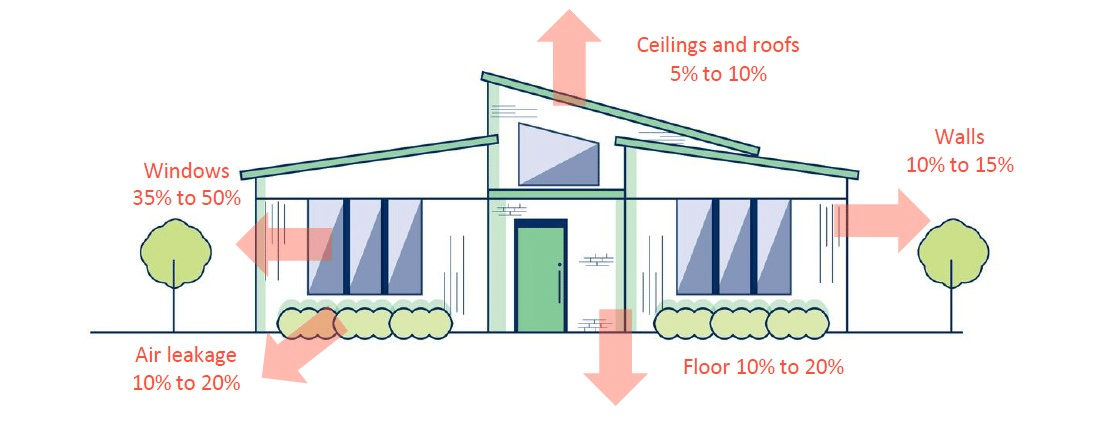
The H1 Clause of the Building Code regulates the energy efficiency of our built environment – covering wall, floor and roof insulation as well as the thermal performance of windows and doors.
Improvements to the requirements under H1 were published by MBIE in November 2021, and more recently, the transition periods for housing were updated.
This hub includes introductory information below, and soon, resources developed specifically for designers and architects, builders, and building officials.
Your new R value
Use our helpful calculator to understand what the thermal performance requirements are for windows and doors in housing. Just select your Territorial Authority.
FAQ’s
How do I know my building’s Climate Zone?
It is based on the building’s site address. You can identify the Climate Zone by Territorial Authority here, on page 23
How does curtain walling fit into H1?
Curtain walling is outside the scope of H1/AS1and H1/AS2, however either H1/VM1, H1/VM2 or an alternative solution can be used to demonstrate compliance.
How do retirement villages fit into H1?
There is a two part response to this question.
i) The individual residences forming part of a retirement village are housing and therefore must comply with H1/AS1.
ii) The other buildings in a retirement village are classified as communal residential, in Clause A1 of the Code, and are therefore not housing and will use H1/AS2 and H1/VM2 to demonstrate compliance.
Is solar gain taken into consideration?
Yes, The modelling method in H1/VM1 and H1/VM2 consider solar gains in the energy balance equation as in previous Editions of H1. However, the Schedule and Calculation Methods in H1/AS1 do not directly consider solar gains, except in the limitation of glazed areas.
Can we still use Colonial Bars under the new H1?
In theory the answer is yes, but there are some difficulties. There are two issues, performance, and manufacturing.
i) The introduction of a colonial bar inside of an IGU will have a negative impact on the overall performance of the IGU, because of what is termed as thermal bridging. That is, that the bar inside the IGU allows heat to transfer through from outside to in, and vice versa. Windows using colonial bar will need to have the glazing modelled to understand the impact of the bars on the overall performance of the unit. Typically, the colonial bar will be installed so it does not contact the surface internal surface of the glass panes. European Standard EN 10077.1 provides what is known as a Psi value to account for the thermal bridging which ultimately reduces the overall IGU U-value. The Psi value varies dependent on the width of the bar, the material used, and its proximity to the glass surface.
So, if colonial bar is used within an IGU the overall performance of the unit is reduced and either the IGU make up will have to be modified to compensate or the insulation in another part of the building’s thermal envelope increased accordingly.
i) There are some manufacturing difficulties when used with Low E glass primarily because the colonial bar should not contact the glass. With clear glass this is not too much of an issue but when the IGU includes a pane of Low E glass there is a risk that the Low E coating might be damaged. There is also risk that the Low E coating might be damaged in larger panes as the glass deflects under wind load possibly contacting the colonial bar.
For this reason, some manufacturers might decline to supply windows and doors where colonial bar is desired.
Association Members – refer to the members area of the site to better understand the impact of Colonial Bars on the thermal performance of an IGU and to access our simple Calculator to establish the impact.
Can we still use Louvres under the New H1?
Yes, louvre windows are still an option, H1 does not prevent their use. However, their use will require that the overall thermal performance of the houselot be calculated to establish compliance of the windows and doors. The Building Code looks at the building’s thermal envelope in its entirety and the calculation method of compliance allows the building designer to compensate for poorer performing elements, i.e., a set of louvres, by increasing the performance of another building element. That might be by increasing the specification of the windows and/or glass or working with the actual glazed area of the building, or it might be by increasing the insulation in the roof, floor and/or walls. The buildings architect/designer has a range of options to ensure the building’s thermal envelope performs as required.
Do skylights comply with the new H1?
In short yes. Table 2.1.2.2B from H1/AS1 includes a specific set or performance requirements for skylights, which are higher than those required for vertical windows in most areas. Use of the Schedule method of compliance limits the size of the skylight to 1.5m2 or 1.5% of the total roof area, and the values from Table E.1.1.1 do not apply! Beyond these limits the performance of the skylight will need to be calculated and the thermal envelope compensated elsewhere for its comparably poor thermal performance.
Will E2/AS1 window details be updated to reflect better thermal details?
MBIE is currently working with industry experts and building researchers to develop window details for E2/AS1 that enable improved thermal performance. This will be included in a future Building Code update consultation.
How can I show compliance with the new requirements?
Clause H1 of the Building Code sets minimum construction R values for windows and doors, but the Consented R value for any particular project may vary from these. It is the window supplier’s responsibility to demonstrate the product they’ve supplied to a specific site, meets or exceeds the R values nominated within the Consent. The ‘Statement of Thermal Performance’ was developed as a simple, one page document, provided with each houselot of windows, declaring the construction R values for windows and doors as supplied, and how the value has been determined.
It is the window supplier’s responsibility to provide the ‘Statement of Thermal Performance’ to their contracted party, usually the builder or homeowner, and it Is their responsibility to ensure the document is passed to the Council. At inspection, if the building inspector requires further information, then supporting documentation can be supplied on request.
What about retro-glazing?
Clause H1 of the Building Code sets minimum construction R values for windows and doors but is aimed at new construction where all the elements of the building envelope are considered. So how does Clause H1 apply to the retro glazing of windows and doors in an existing building?
Section 112 of the Building Act makes allowances for additions and alterations to existing buildings and how the Building Code applies to this type of work. To help explain this, the Association has developed a short Guide to Retro Glazing, for housing only, which can be downloaded from the members area of this site, but the important message is “In most cases a Building Consent will not be required for the retro glazing of existing windows, nor will they need to satisfy the requirements of Clause H1.”.
You should also understand the requirements of the Healthy Home standards for rental properties. The key facts are available here (pdf)
It is important you discuss the needs of your retro glazing project with your glass supplier so that can provide you with a range of options to suit the needs of your project, balanced with your budget.
How do replacement windows comply with Clause H1?
Clause H1 of the Building Code sets minimum construction R values for windows and doors but is aimed at new construction where all the elements of the building envelope are considered. So how does Clause H1 apply to the replacement of windows and doors in an existing building?
Whilst replacement windows are typically new windows being installed into existing openings, the Building Act makes allowances for additions and alterations to existing buildings in Section 112. To help explain this, the Association has developed a short Guide to Replacement Windows, for housing only, which can be downloaded from the members area of this site, but the important message is “In most cases a Building Consent will not be required for ‘like for like’ replacement windows, nor will they need to satisfy the full requirements of Clause H1.”.
You should also understand the requirements of the Healthy Home standards for rental properties. The key facts are available here (pdf).
It is important you discuss the needs of your replacement window project with your window supplier so that can provide you with a range of options to suit the needs of your project, balanced with your budget.
How do I determine my building type?
There are seven building types defined in the Building Code, in Clause A1. You can view these here.
Different requirements for the thermal performance of windows and doors in H1 apply across three categories:
- All housing
- Other buildings (e.g. communal residential, communal non-residential, commercial, industrial etc) Up to 300m2
- Other buildings (e.g. communal residential, communal non-residential, commercial, industrial etc) Greater than 300m2
Note, that where areas of a building or site classify differently (i.e. a small office area, connected to a large warehouse, or a retirement village with both detached dwellings and a communal residential building), each area or building is treated separately.
What do the changes mean for windows and doors?
For housing, initially, aluminium frames will require more thermally efficient glass (double glazing with a high quality Low E pane and an argon gas fill between) to meet the minimum requirements in the first transition period (3 November 2022 to 30 April 2023). From 1 May 2023 however, thermally broken aluminium frames will be required to meet minimum requirements. Many of the uPVC and Timber frame combinations with double glazed Low E IGUs will continue to meet or exceed the standards.
The Quick Reference Guides linked above provide a good overview of how the changes impact glass and framing choices.
Will the changes alter how windows and doors are installed during construction?
No. There is no change in building or installation methods in this edition. However, you can choose to recess windows for better thermal performance. There can be some additional thermal performance gains in recessing windows and doors closer to the buildings primary insulation line, however details for this must also consider the weathertightness of the installation and how compliance with Clause E2 is demonstrated
What are R-values and U-values?
R-values indicate the thermal resistance through a material, so describes how well insulation material resists heat flow. With R-values, the higher the value, the better the insulation and the better the thermal performance.
U-values indicate the thermal conductivity of a material and generally range between 0.1 (small heat loss) and 1.0 (high heat loss). A U-value is the inverse of an R-value, so if heat transfer through a material is minimal, its U-value will be low and its R-value will be high, making it a high-performing insulator.
Both values are used as ratings of energy efficiency. A U-value is often used to describe the performance of IGU’s (insulated glass units) while an R-value is used to describe the overall performance of the window frame and glazing combination.
How do the IGU combinations work in Table E.1.1.1?
Table E.1.1.1 from the new H1/AS1 is a quick and simple tool for understanding the performance of your frame material and glazing combination. The R-values listed in the Table are based on a specific set of Glass U-values as listed in the second left-hand column. Columns 3 and 4 were added to help users understand what the IGU combination might look like in order to achieve the listed U-value. The U-values were calculated based on this information and included the optimal 16mm space between the panes of glass. However, in some cases where the spacer depth is reduced, the IGU make up will vary from the examples, in order to achieve the listed U-value, e.g. you might need to change from a Low E3 to a Low E4 outer pane to compensate for a smaller spacer.

Why are there different types of Low E glass in Table E.1.1.1?
You might notice Table E.1.1.1 includes Low E glass followed by a subscript number, e.g. Low E4. This number is an indicator of the differing types, grades, and performance levels available in the Low E glass genre, as noted in the footnote of Table E.1.1.1. Yes, there a range of different Low E glasses available. There is no definition for the types of Low E, the number simply highlights where the performance requirements of the Low E pane need to be to achieve the nominated U-value.
How do I calculate the performance of an IGU?
Clause H1 requires that glass performance values (U-values) be calculated in accordance with EN 673, the European Standard for determining the thermal transmittance of glass in buildings. To make this simpler we have developed a simple IGU Calculator for understanding the U-value of an IGU based on the panes of glass that make it up, the space(s) between the panes and the gas used to fill that space. The output is a UCOG or U-value at the centre of the glass. The calculator uses verified performance data from each of our manufacturing members.






